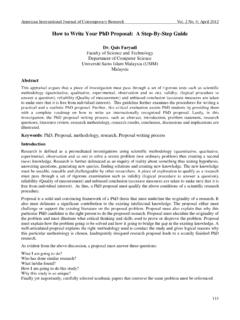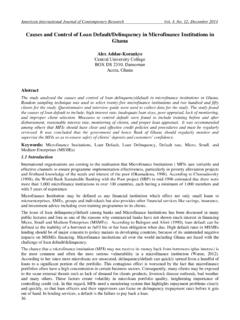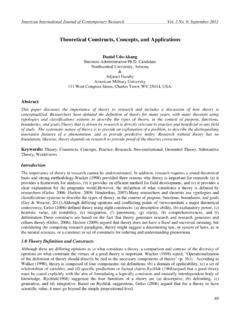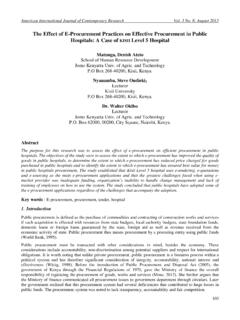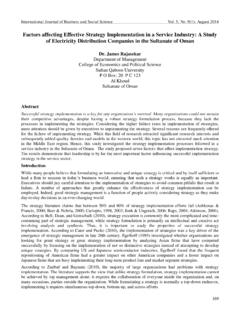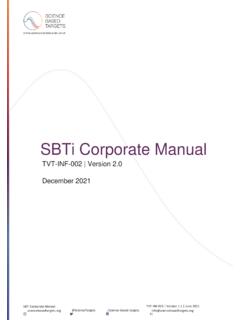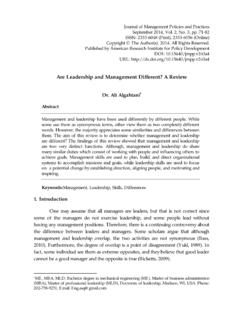Transcription of Management Styles and Organizational Effectiveness: An ...
1 American International Journal of Contemporary Research Vol. 2 No. 9; September 2012 198 Management Styles and Organizational Effectiveness: An Appraisal of Private Enterprises in Eastern Nigeria Nwadukwe, Uche. C Department of Office Management & Technology Federal Polytechnic, Oko, Anambra State, Nigeria. Court Ogele Timinepere Department of Business Studies, Bayelsa State College of Education, Okpoama, Yenagoa Bayelsa State, Nigeria. Abstract The study investigated Management Styles and Organizational effectiveness of private enterprises in Anambra State of Nigeria. A survey design was adopted in this study. The population of the study consisted of top, middle and lower levels of managers of private enterprises across the eight industrial sectors of Anambra State.
2 A sample of one hundred and twenty nine (129) managers was drawn from the three levels of Management of private enterprises from the eight industrial groups. Proportionate Stratified random sampling method was used in the selection of the respondents to ensure fair representation from the three levels of Management . The main instrument for data collection was a structured questionnaire designed in a 5-point Likert scale of strongly agree to strongly disagree and excellent to poor. The data collected were analyzed using descriptive statistics and Pearson product moment correlation statistic. The study found that participative and paternalistic Management Styles were the predominant Management Styles in practice, the effectiveness of private enterprises were well above average, there was a relationship between Management Styles and Organizational effectiveness.
3 It was concluded that different Management Styles were adopted in the running of private enterprises depending on the characteristics inherent such firms. Based on the findings of the study, it was recommended that private enterprises should adopt Management Styles in tandem with the achievement of set goals, cultural values and Organizational peculiarities as there was no one best Management style. Key Words: Management Styles , Organizational Effectiveness, Private Enterprises Introduction Organization is an entity set up for a purpose. The raison d e tre for any going concern is to create utility. The satisfaction of customers is by way of creation of goods and delivery of quality service from any enterprise.
4 For enterprises to remain economically viable and virile, they must attain Organizational effectiveness particularly in today s turbulent business environment. Small and medium scales enterprises are seen as an engine to facilitate economic growth of nations. The Nigerian Government from 1977-1979 formulated an industrial policy to foster the establishment and growth of more small and medium scale enterprises to salvage her economy from recession (Unamka and Ewurum, 1995). Following the establishment of the industrial policy, a wide range of small scale industries sprang up in diverse parts of the country. Anambra State was not left out in the quest for industrialization.
5 The state explored several investment opportunities and was involved virtually in all types of enterprises ranging from transportation, manufacturing and production, electrical and electronics, banking, communication, hotel and tourism, wholesale distribution and others. This really resulted in the creation of more employment opportunities, goods and services, economic growth and improved standard of living. Centre for Promoting Ideas, USA 199 The business environment is fraught with encumbrances arising from the fluidity and dynamics of the world economy and the global business environment.
6 The threats and opportunities occasioned by the uncertainties and changes associated with the business environment stifled the growth of a good number of these enterprises while a few were able to weather the economic storms, exploited the opportunities and improved product quality, productivity and profitability in Anambra State. The decline in the performance and effectiveness of these private enterprises have been attributed to the direction and magnitude of the oil price in the international market, monetary and fiscal policy Management , managerial skills, Management and leadership Styles , obsolete equipment employed, supervisor-subordinate relationship, lack of motivation of workers and the like.
7 Management style is one of the critical antecedents to Organizational effectiveness. Management style is simply construed as a way to manage an organization. It is the general approach of a manager in dealing with people at work and exercising of authority over subordinates in an effort to reach Organizational goals (Quang, 2002; Hartzell, 2006). In view of Organizational effectiveness, Davidmann (1995) opines that the effectiveness of any organization is largely determined by the manner of work co-ordination, level of workers commitment to the entity and the extent to which workers co-operate with one another, Management and the community.
8 There is an avalanche of research conducted with respect to the aforementioned factors responsible for Organizational performance over the years. Specifically, such research was conducted in areas of monetary and fiscal policy Management and enterprise performance, leadership Styles and public enterprises, motivation of workers and Organizational performance. However, little or no attention is directed at the Management Styles and Organizational effectiveness of private enterprises. Consequently, this paper is aimed to fill this knowledge gap by providing empirical evidence. In specific terms, this paper seeks to identify the prevalent Management Styles in private enterprises, assess the Organizational effectiveness of private enterprises and determine as to whether Management Styles adopted has any relationship with the effectiveness of private enterprises in Anambra State of Nigeria.
9 Literature Review Management Styles Management style is a managerial parlance often used to describe the how of Management . It is a function of behavior associated with personality (McGuire, 2005). Management style can be understood as a way to manage an organization. According to Schleh (1977), Management style is the adhesive that binds diverse operations and functions together . It is the philosophy or set of principles by which the manager capitalizes on the abilities of the workforce. Management style is not a procedure on how to do but it is the Management framework for doing. A Management style is a way of life operating throughout the enterprise and permits an executive to rely on the initiative of the personnel of an entity.
10 Effective Management style is the extent to which a leader continually and progressively leads and directs followers to a predetermined destination agreed upon by the whole group. It is the manner of approach to issues of the managers towards achieving the goals of their organization by transforming various resources available to any organization into output through the functions of Management (Field & Dubey, 2001). Khandwalla (1995b) considered Management style as the distinctive way in which an organization makes decisions and discharges various functions of goal setting, formulation, implementation of strategy, corporate image building, dealing with key stakeholders and other basic Management activities.

